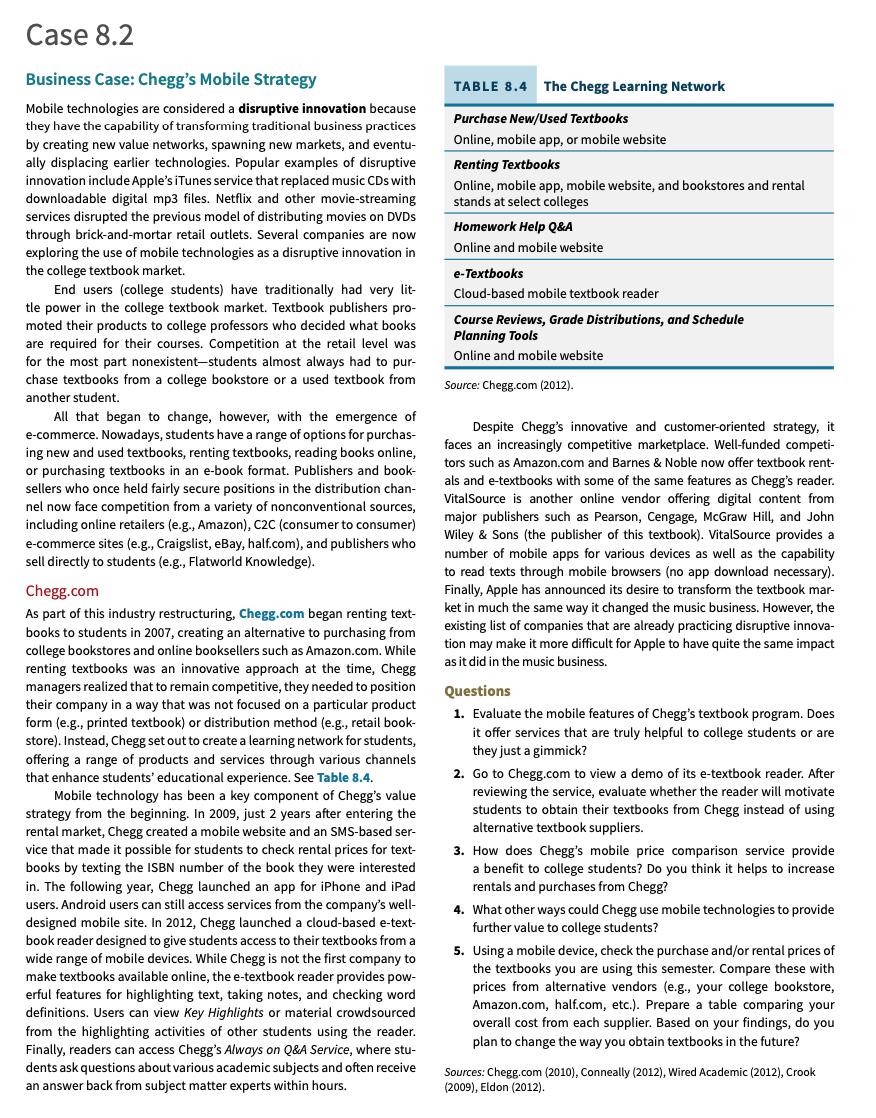
Case 8.2 TABLE 8.4 The Chegg Learning Network Purchase New/Used Textbooks Online, mobile app, or mobile website Renting Textbooks Online, mobile app, mobile website, and bookstores and rental stands at select colleges Homework Help Q&A Online and mobile website e-Textbooks Cloud-based mobile textbook reader Course Reviews, Grade Distributions, and Schedule Planning Tools Online and mobile website Source: Chegg.com (2012). Business Case: Chegg's Mobile Strategy Mobile technologies are considered a disruptive innovation because they have the capability of transforming traditional business practices by creating new value networks, spawning new markets, and eventu- ally displacing earlier technologies. Popular examples of disruptive innovation include Apple's iTunes service that replaced music CDs with downloadable digital mp3 files. Netflix and other movie-streaming services disrupted the previous model of distributing movies on DVDs through brick-and- mortar retail outlets. Several companies are now exploring the use of mobile technologies as a disruptive innovation in the college textbook market. End users (college students) have traditionally had very lit- tle power in the college textbook market. Textbook publishers pro- moted their products to college professors who decided what books are required for their courses. Competition at the retail level was for the most part nonexistent-students almost always had to pur- chase textbooks from a college bookstore or a used textbook from another student. All that began to change, however, with the emergence of e-commerce. Nowadays, students have a range of options for purchas- ing new and used textbooks, renting textbooks, reading books online, or purchasing textbooks in an e-book format. Publishers and book- sellers who once held fairly secure positions in the distribution chan- nel now face competition from a variety of nonconventional sources, including online retailers (e.g., Amazon), C2C (consumer to consumer) e-commerce sites (e.g., Craigslist, eBay, half.com), and publishers who sell directly to students (e.g., Flatworld Knowledge). Chegg.com As part of this industry restructuring, Chegg.com began renting text- books to students in 2007, creating an alternative to purchasing from college bookstores and online booksellers such as Amazon.com. While renting textbooks was an innovative approach at the time, Chegg managers realized that to remain competitive, they needed to position their company in a way that was not focused on a particular product form (e.g., printed textbook) or distribution method (e.g., retail book- store). Instead, Chegg set out to create a learning network for students, offering a range of products and services through various channels that enhance students' educational experience. See Table 8.4. Mobile technology has been a key component of Chegg's value strategy from the beginning. In 2009, just 2 years after entering the rental market, Chegg created a mobile website and an SMS-based ser- vice that made it possible for students to check rental prices for text- books by texting the ISBN number of the book they were interested in. The following year, Chegg launched an app for iPhone and iPad users. Android users can still access services from the company's well- designed mobile site. In 2012, Chegg launched a cloud-based e-text- book reader designed to give students access to their textbooks from a wide range of mobile devices. While Chegg is not the first company to make textbooks available online, the e-textbook reader provides pow- erful features for highlighting text, taking notes, and checking word definitions. Users can view Key Highlights or material crowdsourced from the highlighting activities of other students using the reader. Finally, readers can access Chegg's Always on Q&A Service, where stu- dents ask questions about various academic subjects and often receive an answer back from subject matter experts within hours. Despite Chegg's innovative and customer-oriented strategy, it faces an increasingly competitive marketplace. Well-funded competi- tors such as Amazon.com and Barnes & Noble now offer xtbook rent- als and e-textbooks with some of the same features as Chegg's reader. VitalSource is another online vendor offering digital content from major publishers such as Pearson, Cengage, McGraw Hill, and John Wiley & Sons (the publisher of this textbook). VitalSource provides a number of mobile apps for various devices as well as the capability to read texts through mobile browsers (no app download necessary). Finally, Apple has announced its desire transform the textbook mar- ket in much the same way it changed the music business. However, the existing list of companies that are already practicing disruptive innova- tion may make it more difficult for Apple to have quite the same impact as it did in the music business. Questions 1. Evaluate the mobile features of Chegg's textbook program. Does it offer services that are truly helpful to college students or are they just a gimmick? 2. Go to Chegg.com to view a demo of its e-textbook reader. After reviewing the service, evaluate whether the reader will motivate students to obtain their textbooks from Chegg instead of using alternative textbook suppliers. 3. How does Chegg's mobile price comparison service provide a benefit to college students? Do you think it helps to increase rentals and purchases from Chegg? 4. What other ways could Chegg use mobile technologies to provide further value to college students? 5. Using a mobile device, check the purchase and/or rental prices of the textbooks you are using this semester. Compare these with prices from alternative vendors (e.g., your college bookstore, Amazon.com, half.com, etc.). Prepare a table comparing your overall cost from each supplier. Based on your findings, do you plan to change the way you obtain textbooks in the future? Sources: Chegg.com (2010), Conneally (2012), Wired Academic (2012), Crook (2009), Eldon (2012)







